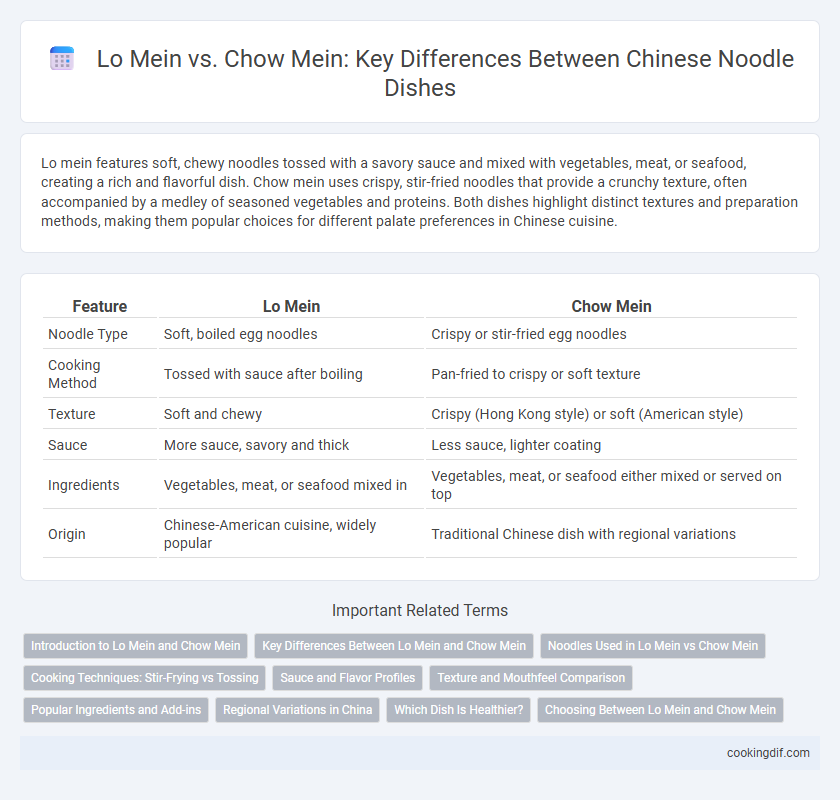Lo mein features soft, chewy noodles tossed with a savory sauce and mixed with vegetables, meat, or seafood, creating a rich and flavorful dish. Chow mein uses crispy, stir-fried noodles that provide a crunchy texture, often accompanied by a medley of seasoned vegetables and proteins. Both dishes highlight distinct textures and preparation methods, making them popular choices for different palate preferences in Chinese cuisine.
Table of Comparison
| Feature | Lo Mein | Chow Mein |
|---|---|---|
| Noodle Type | Soft, boiled egg noodles | Crispy or stir-fried egg noodles |
| Cooking Method | Tossed with sauce after boiling | Pan-fried to crispy or soft texture |
| Texture | Soft and chewy | Crispy (Hong Kong style) or soft (American style) |
| Sauce | More sauce, savory and thick | Less sauce, lighter coating |
| Ingredients | Vegetables, meat, or seafood mixed in | Vegetables, meat, or seafood either mixed or served on top |
| Origin | Chinese-American cuisine, widely popular | Traditional Chinese dish with regional variations |
Introduction to Lo Mein and Chow Mein
Lo Mein and Chow Mein are two popular Chinese noodle dishes distinguished by their cooking techniques and textures. Lo Mein features soft, boiled egg noodles tossed with stir-fried vegetables, meats, and savory sauces, creating a tender and flavorful dish. Chow Mein involves frying noodles until crispy or pan-fried until golden, offering a crunchy contrast combined with similar ingredients and sauces.
Key Differences Between Lo Mein and Chow Mein
Lo mein features soft, boiled noodles tossed with a savory sauce and mixed with vegetables or protein, creating a saucier and tender texture. Chow mein uses thin, stir-fried noodles that are either crispy or slightly crunchy, resulting in a distinct texture contrast within the dish. The cooking techniques and noodle types define the primary differences in flavor and mouthfeel between these classic Chinese noodle dishes.
Noodles Used in Lo Mein vs Chow Mein
Lo mein noodles are thick, soft, and boiled, providing a chewy texture that absorbs sauces well, while chow mein noodles are thin, crispy, and either fried or pan-fried to create a crunchy contrast. The egg noodles used in lo mein have a higher moisture content, making them tender and ideal for stir-frying with sauces and vegetables. Chow mein noodles have lower moisture and a firm texture, allowing them to crisp up during cooking, which distinguishes the two dishes fundamentally by the noodle preparation and texture.\
Cooking Techniques: Stir-Frying vs Tossing
Lo mein and chow mein differ primarily in cooking techniques, which influence their texture and flavor. Lo mein involves tossing boiled noodles lightly in a wok with sauce and ingredients, preserving a soft, chewy texture. Chow mein requires stir-frying noodles at high heat until they develop a crispy exterior, delivering a distinct crunch paired with tender vegetables and proteins.
Sauce and Flavor Profiles
Lo mein features a thicker, soy-based sauce that lightly coats the soft, egg noodles, creating a savory and mildly sweet flavor profile. Chow mein offers a drier texture with a more intense, slightly smoky soy sauce combined with stir-fried vegetables and crispy noodles, enhancing umami richness. The key difference lies in the sauce application and noodle texture, with lo mein emphasizing moist, saucy noodles and chow mein prioritizing a crisp, robustly flavored experience.
Texture and Mouthfeel Comparison
Lo mein features soft, chewy noodles that absorb sauces, creating a tender and smooth mouthfeel, while chow mein offers crispy, stir-fried noodles with a satisfying crunch. The texture of lo mein is dense and elastic due to boiling, contrasted by chow mein's light, brittle quality achieved through frying. This fundamental difference in preparation directly influences the eating experience, with lo mein delivering a rich, saucy bite and chow mein providing a crisp, layered texture.
Popular Ingredients and Add-ins
Lo mein typically features soft, boiled noodles tossed with a mix of popular ingredients such as sliced chicken, beef, shrimp, bok choy, and carrots, often coated in a savory soy-based sauce. Chow mein uses crispy, stir-fried noodles combined with ingredients like bean sprouts, onions, bell peppers, and sometimes water chestnuts, delivering a contrasting texture. Both dishes frequently include garlic, ginger, and scallions to enhance their bold, aromatic flavors.
Regional Variations in China
Lo mein and chow mein represent distinct Chinese noodle dishes with key regional variations primarily between northern and southern China. In northern regions, chow mein often features crispy, stir-fried noodles, reflecting a preference for heartier textures, while southern versions favor soft, steamed noodles similar to lo mein, which is characterized by boiled noodles tossed in a savory sauce. These regional differences highlight the diverse culinary traditions across China, influenced by local ingredients and taste preferences.
Which Dish Is Healthier?
Lo mein and chow mein differ primarily in cooking methods, influencing their nutritional profiles and health impacts. Lo mein noodles are boiled and then tossed with ingredients, resulting in a higher water content and potentially fewer calories, while chow mein noodles are stir-fried or deep-fried, increasing oil absorption and fat content. Choosing lo mein can generally be healthier due to its lower oil content, but the overall healthiness depends on specific recipe ingredients and portion sizes.
Choosing Between Lo Mein and Chow Mein
Lo mein features soft, boiled noodles tossed with vegetables and meat, offering a chewy texture ideal for absorbing rich sauces. Chow mein uses crispy, stir-fried noodles that provide a crunchy contrast to tender stir-fried ingredients, making it a popular choice for textural variety. Selecting between lo mein and chow mein depends on preference for texture--soft and saucy versus crispy and stir-fried--both delivering authentic Chinese noodle flavors.
Lo mein vs Chow mein for Chinese noodle dishes Infographic

 cookingdif.com
cookingdif.com